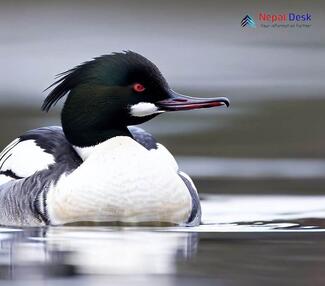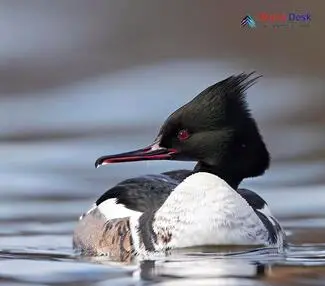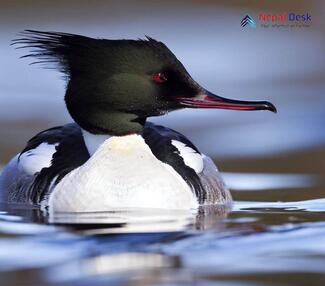Nepal, a country known for its rich biodiversity and stunning landscapes, is home to a diverse range of bird species. One unique and captivating bird that can be found in this beautiful country is the Common Merganser (Mergus merganser). It was first officially described by the renowned Swedish naturalist Carl Linnaeus in 1758 in the 10th edition of his work Systema Naturae. He assigned the bird its present scientific name, Mergus merganser. In 1843, John James Audubon referred to this bird as both the "Buff-breasted Merganser" and "goosander" in his acclaimed publication The Birds of America.
Let us look at the various aspects of this large seaduck:
Appearance and Identification
The Common Merganser is characterized by its elongated body, lengthy and narrow bill, and striking plumage. Adult males are easily recognizable with their glossy green-black head, white body, and black back. The females display a more subtle beauty, sporting a rusty brown head and grayish body. When in flight, these birds reveal their white wing patches which serve as excellent identification markers.
Habitat and Distribution
In Nepal, the Common Merganser can usually be found in fast-flowing rivers within a variety of altitudes. They prefer clean water sources with an abundance of fish – their primary food source. During migration periods and winter months, these birds can also be spotted along lakeshores or wetlands. They have been reported throughout various regions of Nepal but are most often sighted around major river systems such as Kali Gandaki, Trishuli, Narayani, Khola Karnali, Phewa Lake, Rara Lake, and Ghodaghodi Lake.
Diet and Hunting Techniques
Common Mergansers primarily feed on fish such as minnows, salmonids, and other small aquatic prey. They are skilled hunters that utilize various techniques in order to capture their prey successfully. Diving underwater to locate fish, these mergansers can reach depths of up to 20 feet and swim against powerful currents with ease. Their serrated bills allow them to firmly grip slippery fish once caught.
Breeding and Nesting
Breeding season for the Common Merganser commences from April to June. These birds are cavity nesters, usually laying their eggs in natural tree holes, cavities created by woodpeckers, or even artificial nest boxes. Females alone are responsible for incubating the eggs and tending to their young, which typically consist of 8-12 chicks. Remarkably, the young mergansers are able to leave their nest and begin swimming within a day of hatching.
Conservation Status
The Common Merganser is classified as a species of Least Concern on the IUCN Red List, as it has a large global range and stable population numbers. However, human-induced habitat destruction and water pollution can pose threats to this beautiful bird's survival in specific regions. Exploring Nepal's exquisite landscapes and watching vibrant birdlife can be a fulfilling experience for both avid birders and nature enthusiasts alike. The Common Merganser adds a unique charm to Nepal's avian community, making it one extraordinary species worth discovering.




